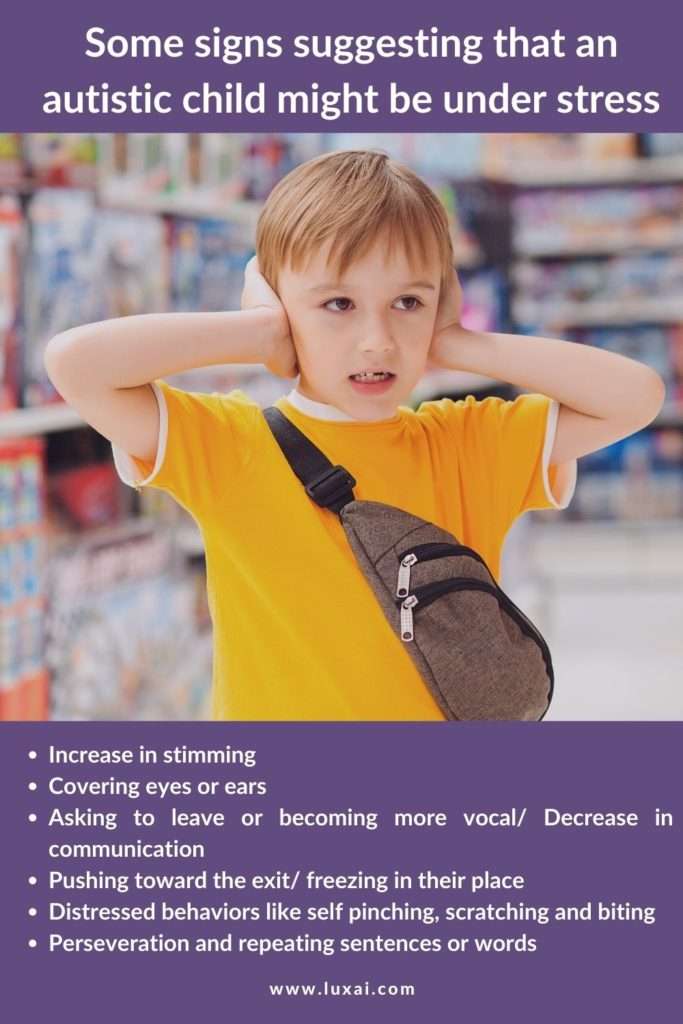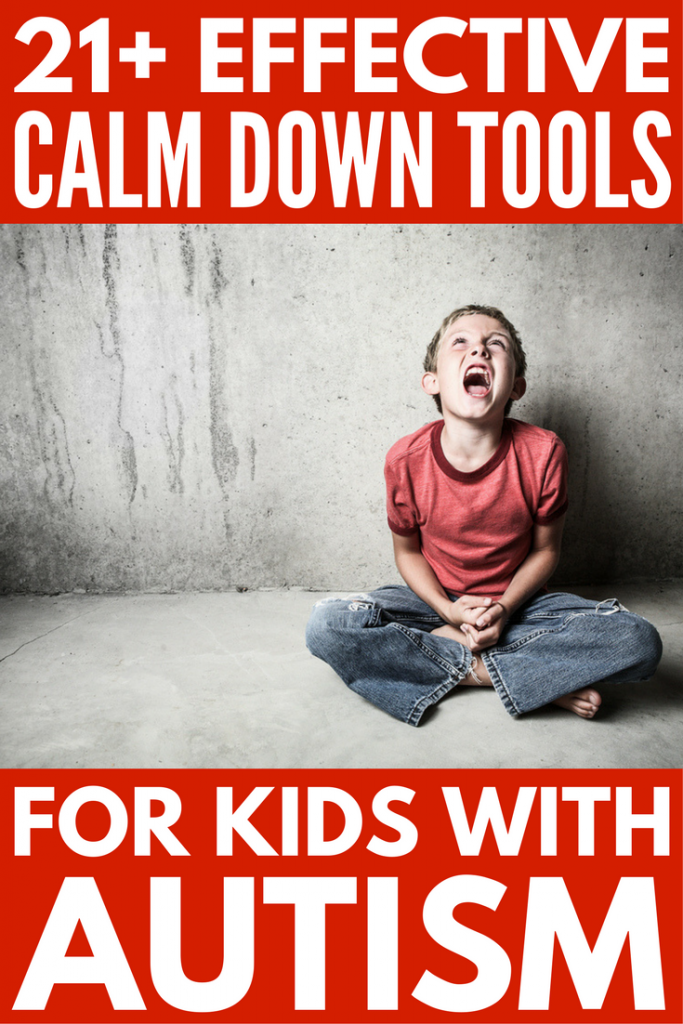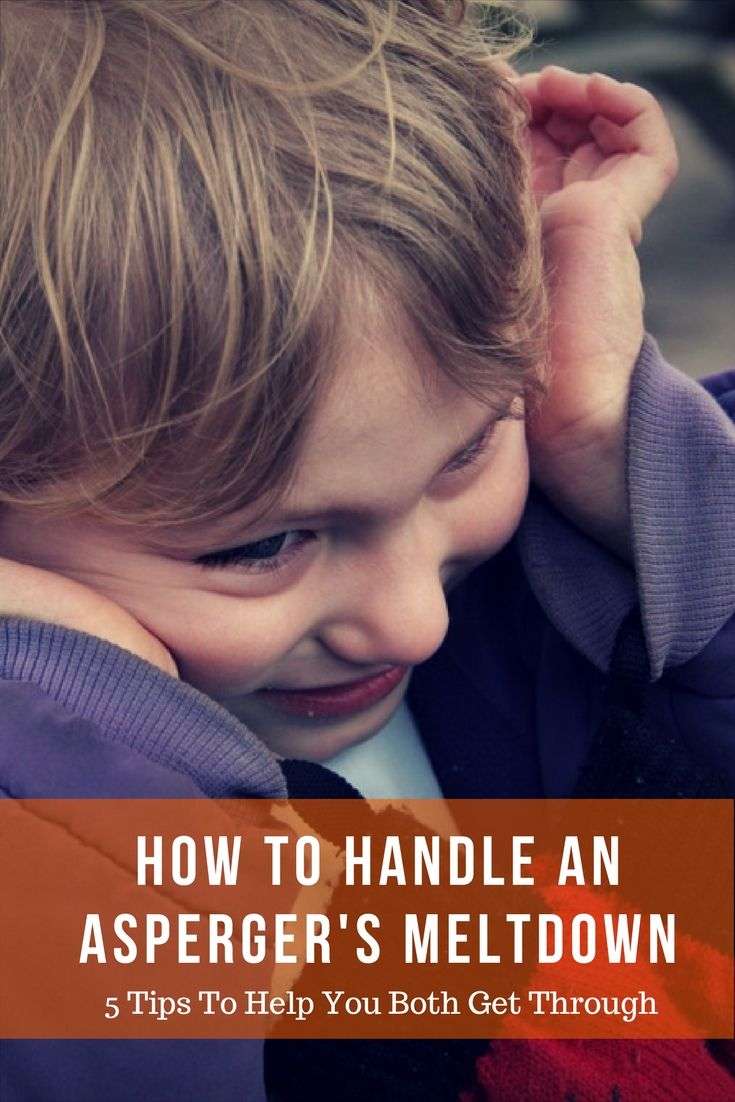Tantrum Vs Autistic Meltdown:
A tantrum is often a goal-oriented action. Often young children learn that by tantrums they can achieve a reward such as a wanted behavior or a desired object. Children often have a request and when it is declined, they learn that by throwing a tantrum they can frustrate their parents or teachers and reach their goal. As soon as the child achieves the goal, the disruptive behavior quickly ends, since there is no reason to display it anymore.
However, autistic meltdowns are not created as a reward request system. They are not limited to just children and they can happen at any age or situation. A meltdown is often caused by sensory overstimulation. Many people with autism have an oversensitivity to various stimuli such as sounds, smells, lights, etc. The oversensitivity can cause the person to get overwhelmed, which leads them towards having a meltdown. Meltdowns are often more severe and emotional, more long-lasting and more difficult to handle than tantrums.
As mentioned, tantrum often happens in younger children and as the child grows up, they become less and less frequent. However, autistic meltdowns are not age-related and they may happen at any age. Many autistic adults, especially the higher functioning ones, may learn some strategies to prevent meltdowns and cope with them.
Coping Strategies For Dealing With Meltdowns
Meltdowns are something which many people with autism experience and which they may have experienced since childhood. Meltdowns can be distinguished from tantrums on the basis of having no end-goal in sight. You dont have a meltdown because you want to achieve something from it . You have a meltdown because you have absolutely no other way of responding to a situation. In terms of emotional regulation, youve completely lost your ability to maintain control.
Meltdowns may result in you screaming, crying, throwing things, shaking, and/or yelling hurtful comments. They can be scary and damaging to people around you and, when youve had a meltdown, chances are you feel pretty bad about it.
So how can you deal with the fallout? The following strategies may help.
1. Accept that you did not want to act in this way.
2. Have a safe place for the immediate aftermath.
3. Working with those people close to you.
Meltdowns have an impact on people close to you and witnessing someone who is having a meltdown can be a disturbing experience. When you are ready to, it is important to discuss your meltdown with those people who may have been affected by it. It could also be useful to show them some autistic resources which explain the experiences of other people with autism who experience meltdowns, as it can be a very difficult concept for other people to understand.
4. Recognise when a meltdown is coming.
Try To Understand What Exactly Caused Such Behavior
Possible causes:
Recommended Reading: Is There Treatment For Autism
Whats The Difference Between A Meltdown And A Tantrum
A good place to start is by understanding the difference between a sensory meltdown and a tantrum. The two are easily confused which is why many dismiss meltdowns as nothing more than a badly behaved childs cry for attention. This couldnt be further from the truth.
Tantrums are behavioural outbursts which are a deliberate attempt to get something. A child could have a tantrum for many different reasons. They could, for example, want their parents attention or perhaps they want their parents to buy a specific toy. Unlike meltdowns, a child having a tantrum is in control of their behavior, and will most likely stop acting out when they get what they want. Tantrums and meltdowns are very different and cannot be handled in the same way. By simply dismissing a meltdown as a petulant child acting out, you can cause severe harm to a child with special needs.
We put together some tips which may help you calm your special child during these trying times. But remember, what calms one child with special needs may not work for another. The important thing is to be understanding, patient and loving. That is after all what a child needs most during a sensory meltdown.
Using Visual Schedules Can Help Children With Autism To Have A Predictable Plan And Stay Calm

4. When your child is calm, practice self-regulation and calming down activities:
It is very helpful to take your time and practice some structured activities that can help children to calm down and control their emotions. However, in order to be able to help children to learn how to calm down, we need to first make sure they can recognize their feelings, they can understand how each emotion is felt and triggered and to know what are the emotions that are negative or too intense and can cause meltdowns or inappropriate behaviors.
Recommended Reading: Is Autism Genetic Or Hereditary
How To Manage A Meltdown
There are two types of meltdown: one is outwardly directed, an explosion of emotional energy that is destructive, with feelings of rage and actions of destruction the other is an implosion, with energy that is inwardly directed and expressed as intense despair, self-harm and suicidal thoughts. There is a potential third meltdown, or shut down. This is behaviour that acts as a means of self-protection. The person is physically immobilized, or frozen, and may even fall asleep as a means of switching off.
A meltdown is a psychological crisis, and there are recommendations regarding what to do and what not to do when a meltdown occurs. The following suggestions can help to minimize the depth and duration of a meltdown. The following suggestions are strategies to use in an outwardly directedexplosion, or rage attack.
What Do Tantrums Look Like
Tantrums differ from one child to another. They can be spectacular explosions of anger.
The child may lose it with frustration and disorganized behavior.
During tantrums , the child may cry, stiffen up, scream, kick things around, fall down or run away. Some children hold their breath, and some even vomit.
They may break things around the house. Children with autism could get aggressive when they are throwing a tantrum fit.
This is how autistic children may express their frustration with the challenges that they are facing.
Thirst , hunger, tiredness: Some examples that can lead to tantrums.
When they get frustrated, they get angry. And when they get angry, they can throw a tantrum.
Come along with 200k+ families!
Let’s communicate better!
Also Check: Does Freddie Highmore Have Autism In Real Life
Autism Meltdowns Come From Overwhelm Or Overstimulation
Next, lets answer the question. What is an autism meltdown? A meltdown is when the child loses control over his behavior and can only be calmed down by a parent, or when he reaches the point of exhaustion. These will sometimes be referred to as autism outbursts, but we will refer to it solely as an autism meltdown in this article.
Meltdowns are reactions to feeling overwhelmed and are often seen as a result of sensory overstimulation . Tantrums can lead to meltdowns, so it can be hard to tell the difference between the two outbursts if youre not attuned to your childs sensory signals.
For more information on sensory processing, check out Harklas article here.
When a person with autism experiences too much sensory stimulation, their central nervous system is overwhelmed and unable to process all of the input. Its a physiological “traffic jam” in your central nervous system and the sensory overstimulation is not unlike a maladaptive response to an actual traffic jam.
Weve all had the experience of happily driving to our destination, cruising down the highway singing along to our favorite song, when all of a sudden traffic comes to a dead stop. Now, instead of comfortably cruising , youre at a standstill surrounded by imposing big trucks, offensive exhaust fumes, blaring horns, and the blazing hot sun peeking through your windows.
The last thing you want is to be stuck in your car in that traffic jam – you want out!
Break Out Your Sensory Toolkit
Keep a few sensory tools or toys in your car or bag. You can offer these to your kid when their mind is overwhelmed.
Kids have different favorites, but some common sensory tools include weighted lap pads, noise-cancelling headphones, sunglasses, and fidget toys.
Dont force these on your child when theyre melting down, but if they choose to use them, these products can often help them calm down.
Read Also: How To Deal With Autistic Temper Tantrums
Focus On Your Child Not Staring Bystanders
Meltdowns for any child can get noisy, but they tend to go to a whole other level of loud when its an autistic child.
These outbursts can feel embarrassing to parents when were in public and everyone is staring at us.
We feel the judgment from some saying, Id never let my kid act like that.
Or worse, we feel like our deepest fears are validated: People think were failing at this whole parenting thing.
Next time you find yourself in this public display of chaos, ignore the judgmental looks, and quiet down that fearful inner voice saying youre not enough. Remember that the person who is struggling and needs your support the most is your child.
What To Do And What Not To Do When Your Autistic Child Is Experiencing A Meltdown
You can follow these 5 tips to help a child experiencing an autistic meltdown:
1. Make sure the child is safe:
The most important point in helping a child or an adult who is having an autistic meltdown is to ensure their safety! Due to the magnitude of the sensory overload, there is always a possibility for the child to get hurt while having a meltdown. Therefore, we need to try to protect them and make sure they are safe. It might be necessary to remove the child from the environment and take them somewhere quiet, so they feel safe.
- Get them to a place where they feel safe. It is often the most effective way to deal with a meltdown.
- Get them to a corner or to the car, can be a good option when you are out.
- Try to hold them if there is a possibility of them hitting their head or injuring themselves.
2. Make sure you are staying safe as the childs helper:
It is not uncommon for kids to unconsciously hurt others while having a meltdown. Especially when they grow up it can be very possible to hurt their parents who are trying to help them. So, make sure you wont get hurt while you are helping them. If the child is physically large, often this requires more than one person to move the child to a calm and quite place without causing any injury.
3. Dont try to talk to them and reason with them during a meltdown:
4. Try to stay calm:
5. Dont try to discipline them during a meltdown:
Don’t Miss: Is My Child Autistic Or Gifted
Visual Schedules Social Stories Check
Wed all like to avoid meltdowns completely, but thats not possible. Instead, some parents find it helpful to put strategies in place to minimize the stress and anxiety of daily life that may contribute to a meltdown. Visual schedules, social stories, check-off lists, and activity or task schedules will be helpful in communicating to your child what is planned, and what the expectations will be. If youre planning an outing to the mall or grocery store, an online search can turn up actual photos of the store. Social stories that walk a child through the plan, from beginning to end, will offer predictability and a sense of control that may reduce anxiety. Over time, building in a surprise or question mark to visual schedules will help to shape behavioral responses to unexpected changes in routines or outings that are often stressful.
Read Also: Outgrowing Autism
Invest In A Good Weighted Blanket

Weighted blankets can be very effective for children who have frequent meltdowns. These blankets apply mild pressure to the body, helping an anxious child calm down. In addition, the weights in the blankets help improve a childs body awareness which can reduce the severity of the meltdown. Alternatively, weighted vests give similar calming sensory feedback, and are a great option for summer and travel.
Don’t Miss: How To Know If Youre Autistic
How To Use An Autism Meltdown Kit
A meltdown kit or a calm down kit is a customized set of objects that help prevent or de-escalate a childs meltdown.
To create your own meltdown kit, you need to ask yourself the following questions:
What kind of toys/activities does my child like to do?Can this item help stop or lessen a meltdown?Does this item have the texture/shape/color my child likes?
Based on the answers to your questions, here are some items that can be included in your childs kit:
- Fidget toys
- Puzzles
- Musical instrument
Note that giving this kit to your child is ideal for preventing a meltdown. It might not work if the child is already in the middle of a meltdown.
Meltdowns Advice & Support For:
Our advice and guidance on meltdowns will help you understand what a meltdown is, their causes and how you can help.
A meltdown is an intense response to an overwhelming situation. It happens when someone becomes completely overwhelmed by their situation and temporarily loses control of their behaviour.
This page gives you an overview. For more information about how to anticipate meltdowns and minimise their frequency, select from the menu above or the guide link below.
Don’t Miss: Do Babies With Autism Babble
A Complete Guide On How To Prevent And Manage Meltdowns
Beaming Health
Highlights
- While its not always possible to avoid a meltdown, there are strategies that can help
- Prepare your child for outings by ensuring theyre well rested, well fed, and have used the restroom before leaving the house
- Teach your child coping strategies and practice when theyre feeling calm so your child can learn to manage their reactions
- When meltdowns happen, try your best to remain calm and make sure your child is in a safe place
Meltdowns can be a scary and exhausting experience for parents and children. An autistic child can experience an intense explosion of emotions if triggered by change or unexpected situations. They can cry uncontrollably, scream, hurt themselves, or zone out. Meltdowns can last for a few minutes to a few hours.
Key Strategies For Handling Autistic Meltdowns
Parents and caregivers often face challenges when dealing with autistic meltdowns. There is not much you can really do to calm your child down during an episode, but there are some ways to help reduce the severity of the event and keep them safe.
This article explores the most common causes of autistic meltdowns and how to distinguish them from temper tantrums.
Also Check: Non Stimulant Treatment For Adhd
What Is An Autism Meltdown
A meltdown is defined as an intense reaction to sensory overwhelm. When a child with autism is overwhelmed, he/she knows no other way to express it other than with a meltdown. This might involve emotional verbal outbursts such as screaming and crying or physical reactions like kicking, biting or hitting.
Understanding Why Meltdowns Occur
There are underlying factors that contribute to meltdowns and other atypical emotional responses. The behaviors are based on limitations seen in most children with autism, including:
- Difficulty understanding social norms and conventions
- Difficulty following or using non-verbal communication
- Unawareness of others’ likely reactions to behaviors
- Sensory challenges that can get in the way of positive behaviors
- Lack of social motivation or the desire for social acceptance
Recommended Reading: Does My Child Have Aspergers Or Autism
Signs Indicating That An Autistic Child Is Going To Have A Meltdown
3. Is there an audience for the childs behavior or not?
Tantrum is a way for children to get the attention of their parents and adults and to lead them to do something that the child wants. Therefore, tantrums always happen when there is an audience.
For example, if the child is alone or not with parents or direct caregivers, they would not have a tantrum.
Autistic meltdown, however, is not an act to attract attention and reach a goal. Therefore, they can happen in any situation and especially more often when children are away from their parents and they are dealing with new people and new situations. Based on the type of sensory sensitivity one individual may have, they can happen in various environments and they are not necessary coming after a request is denied.
What Its Like To Have A Severe Autism Meltdown

One of the biggest fears a person can have is loss of control of self. The other is fear of the unknown. For many with autism, the unknown can trigger a loss of control. One great fear leads to another.
There are many sources out there that will tell you why we do what we do. . Articles will explain why we cannot handle change. Speakers will express the process of transition. Trainers will teach the need for scheduling and routine. However, there comes a point where none of these suggestions is helpful, and a meltdown still occurs. Like a seizure, it can happen out of nowhere, and it can be very frightening and traumatic for the autistic person . Especially when the cause of the meltdown is unknown. It is terrifying!
You may be very used to meltdowns that your child or adult child may have. However, a meltdown can look quite different in another person. Meltdowns can look like any of these actions: withdrawal or outward distress . Since you have experience with autism, you can offer help to that person in distress.
Also Check: What Causes Your Child To Have Autism